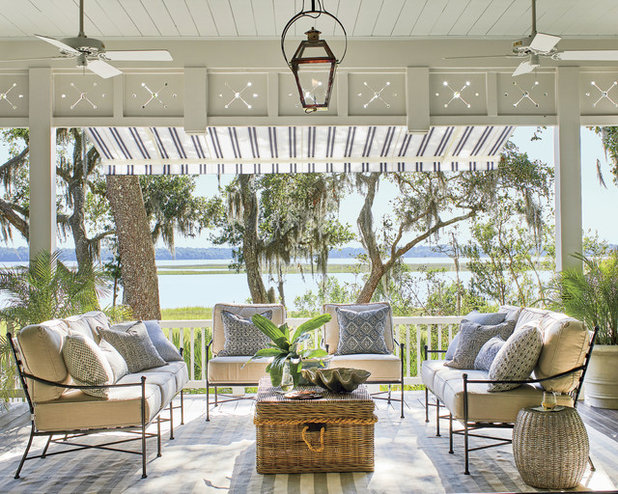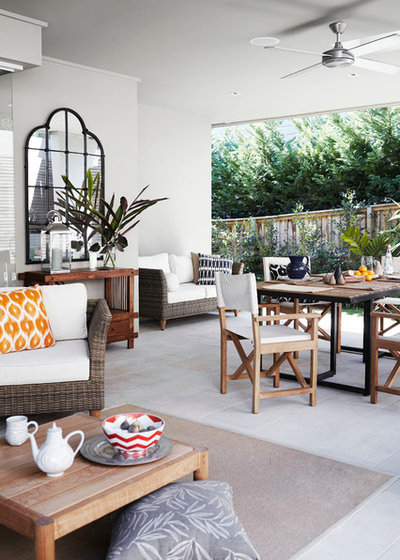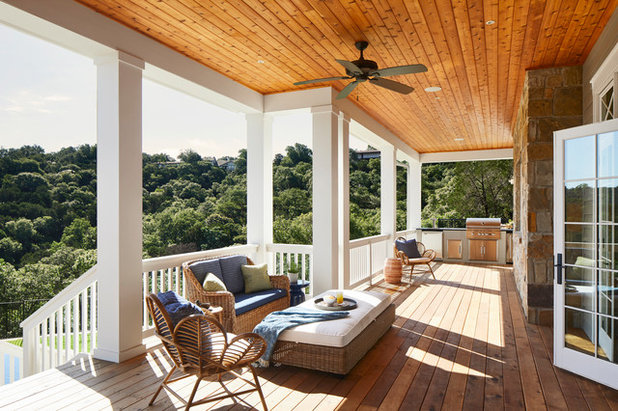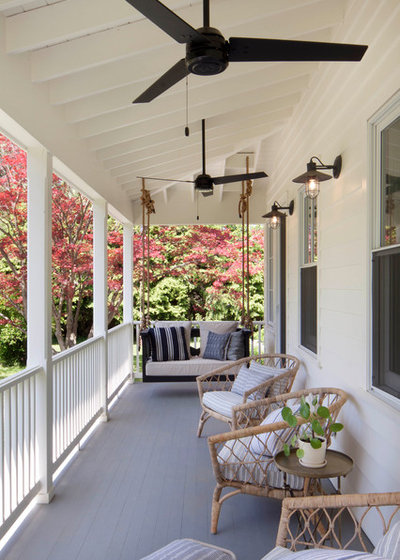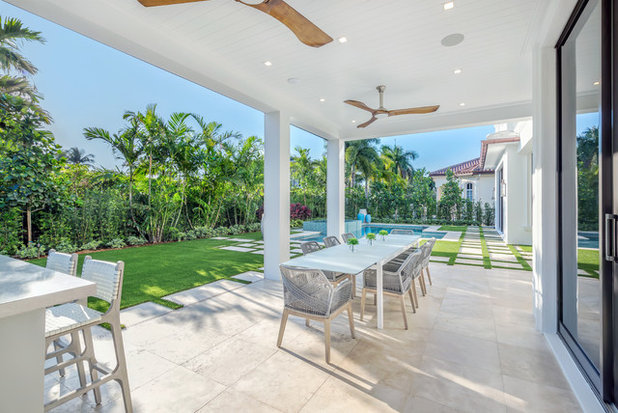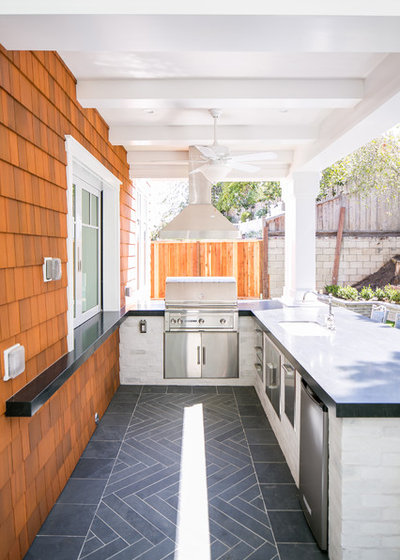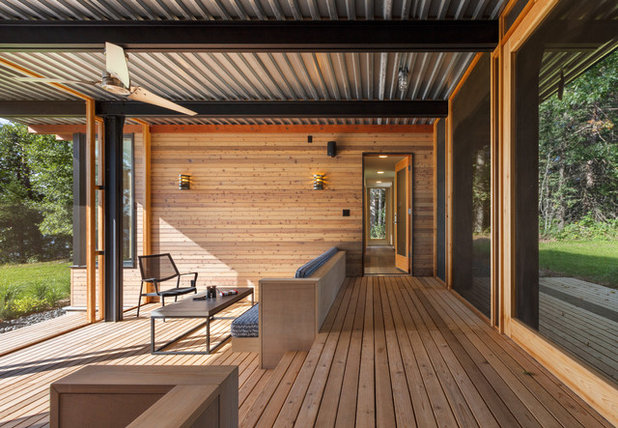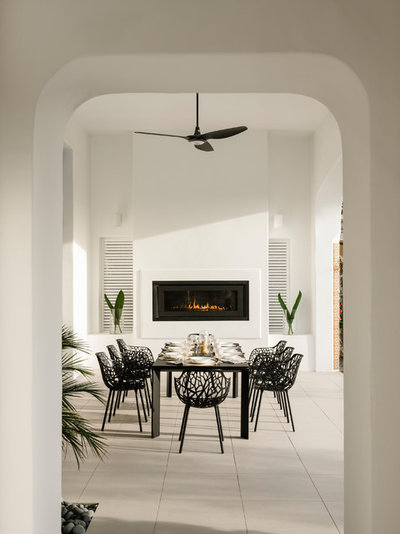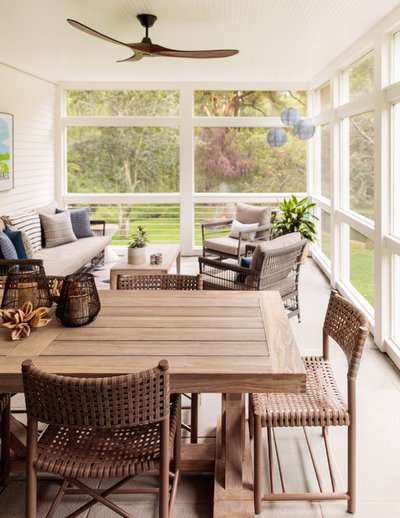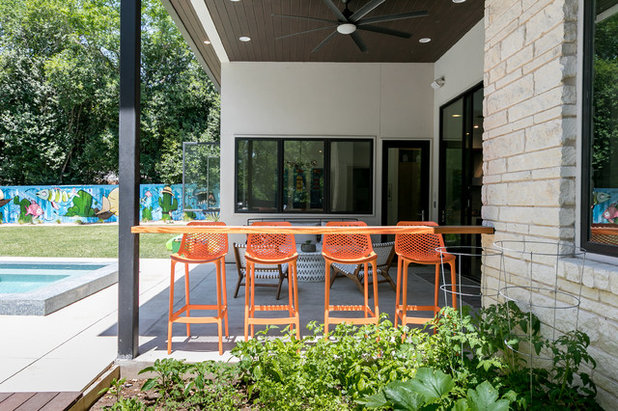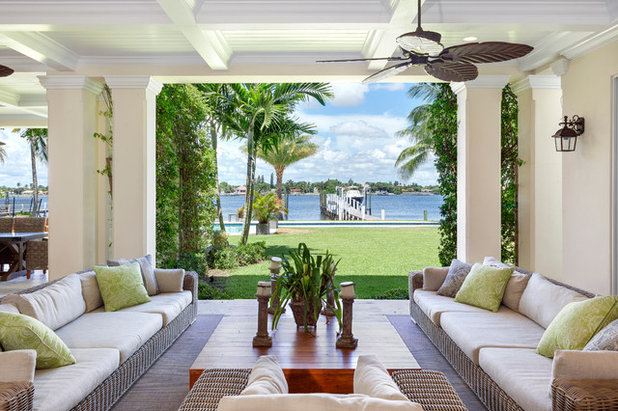Cool Down With These Stylish Ideas for Outdoor Ceiling Fans
The following breezy designs offer ideas both for style and function for adding ceiling fans to outdoor spaces. Could you see any of them working for your porch or patio?
A pair of simple, traditional-style ceiling fans with classic metal detailing helps cool down this porch on the water in Jacksonville, Florida, and tie in with the home’s plantation style. Choosing the fans in the same color as the ceiling, in this case white, ensures that they don’t compete for attention with the outdoor pendant light or the gorgeous view.
Shop for an outdoor ceiling fan on Houzz
A ceiling fan with a chrome finish looks elegant and cool in this covered veranda in Sydney. The material complements the contemporary home’s other finishes and accents, such as the silver outdoor lanterns and trays.
For verandas with deep overhangs set against buildings, a ceiling fan can make a big difference in boosting air circulation and cooling down the space. The longer the blades of the fan, the larger the room it can cool.
A classic black outdoor fan set right where it’s needed cools down the seating area of this deck in the Northgrove neighborhood of Austin, Texas. The dark color contrasts the wood of the ceiling, adding interest and anchoring the seating area outside the home by Studio Steinbomer.
Ready to add an outdoor ceiling fan? Find a professional installer on Houzz
Multiple clean-lined black ceiling fans help take this farmhouse porch from traditional to what the architects at Garrison Foundry Architecture + Decor call “Scandi Modern,” coordinating well with the barn-style wall sconces along the front of the home.
In a narrow space, such as a porch, multiple ceiling fans installed to run the length can ensure that all areas are nice and breezy.
A pair of ceiling fans with live-edge wooden blades becomes the focal point of this covered dining area staged by Ava Gray Interiors. The curvaceous shapes of the blades work well in a tropical landscape, where organic shapes, bold plants and natural wood furnishings often dominate.
There are cases where you’d like to show off a ceiling fan as part of a patio design, and in other situations it’s best for the fan to fade into the background. This outdoor kitchen and entertainment terrace outside an Orange County, California, house by James David Custom Homes falls into the latter category.
The design has a lot going on in terms of materials and finishes, between the wood shingle siding, herringbone slate floor and white brick veneer covering the kitchen built-in unit. Thanks to its white color, the ceiling fan visually disappears into the ceiling instead of adding any busyness to the space.
This angular metal ceiling fan fits in well with the contemporary architecture of this lake house by SALA Architects in Minnesota. Mounted above a covered seating area and breezeway looking out over the water, the ceiling fan keeps the area cool and comfortable.
For a contemporary, indoor-outdoor patio in a Spanish-style home by Nicholas Lawrence Designin Southern California, a sleek black ceiling fan anchors a dining table and draws the eye upward. The clean, minimalist style of the fan balances the graphic pattern of the dining chairs while also providing balance in the space by pulling up the black.
Fan: Haiku, Big Ass Fans
For a farmhouse set in New England’s Berkshire mountains, a ceiling fan made with curved, polished wood blades looks more like a beautiful antique than a standard home appliance. The style complements the rich wood materials used throughout the home, designed by Jess Cooney Interiors, bringing a warm tone to the primarily white covered porch.
Ceiling fans with more than the typical three to five blades can become surprising focal points in a design. In this shaded terrace by Urbane Design in Austin, Texas, an eight-blade ceiling fan looks handsome mounted above bar seating and can produce a welcome breeze overhead.
1. Wet-rated vs. damp-rated. Outdoor fans labeled as wet-rated are the ones to choose for outdoor use, and they come in a wide range of styles. Wet-rated means they are waterproof, UV-protected and can withstand exposure to rain, snow, high-humidity and even cleaning with a blast of a garden hose. They are best suited for outdoor pergolas, porches, verandas and decks that have some exposure to the elements. Damp-rated outdoor fans are not waterproof but are rust-resistant when exposed to humidity and are suitable for use in very sheltered outdoor areas like screened-in porches or garages. Dry-rated fans are intended for indoor use only.
2. Fan size and placement. The size of a fan — specifically the diameter of the circle cut by the blades – will determine how much cool air it’s able to move. For a larger outdoor area, consider installing larger fans or multiple smaller fans, as layout allows. The placement of a fan within an outdoor room also affects how efficiently it can cool a space. Professionals often recommend mounting a fan 8 to 9 feet above the ground and at least 12 to 18 inches away from walls.
3. Motor type. Investing in a high-quality fan motor will more likely reduce common annoyances, such as fan noise and wobble, and increase the chances that the fan will work for years. Ceiling fans with DC motors are more energy-efficient than those with AC motors and often have more options for speed and reversing fan direction.
4. Extra features. Built-in lighting fixtures in ceiling fans can be useful for areas where you would like a lighting and cooling function in the same overhead position. Remote controls for fans, which enable you to turn them on or off and adjust for speed, are also common.
